Gulf Coast tick
Amblyomma maculatum
Identification
Female Gulf Coast ticks have a dark brown scutum (a plate on their back) with silvery white stripes. The male tick’s scutum is dark brown, also with silvery white lines, but the males’ lines are interconnected have a tortoiseshell-like appearance.7
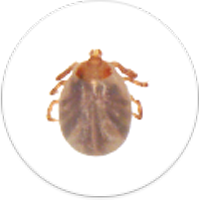
Nymph
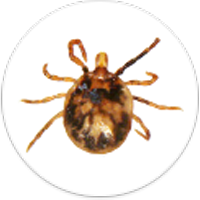
Male
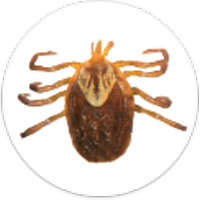
Female
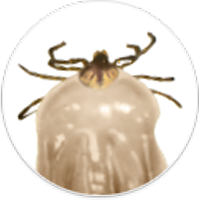
Engorged Female
Approximate Distribution
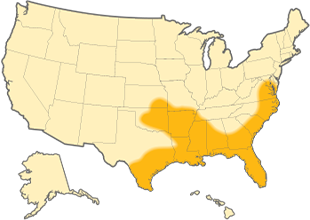
As the name suggests, the Gulf Coast tick is primarily found in the Gulf Coast states. It’s also found in central and eastern Oklahoma and parts of central and eastern Kansas.8
Hosts

Each active life stage feeds on a different host. Generally, Gulf Coast tick larvae and nymphs feed on small animals like rodents, rabbits, and birds. Adults feed on larger animals including dogs, coyotes, and skunks.7
Habitat

Gulf Coast ticks are found in grass prairies and coastal uplands.7
Diseases associated with Amblyomma maculatum20
Hepatozoonosis
Hepatozoonosis is a disease caused by Hepatozoon parasites. It affects both cats and dogs, with varying severity. In cats, the disease can range from asymptomatic (showing no signs) to potentially life-threatening. In dogs, it can be severe to fatal if not properly managed.36, 37
Clinical Signs
In dogs:36
● Fever
● Weight loss
● Poor body condition
● Muscle atrophy
● Pain
● Weakness
● Eye discharge
Cats rarely show any clinical signs of infection.37
Diagnosis and testing
For dogs, diagnosis usually involves an evaluation of the dog’s clinical signs and medical history as well as x-rays and blood, tissue and other types of laboratory testing. In cats, diagnosis is challenging because cats rarely show signs of the disease, but the disease can be diagnosed by identifying the parasite within blood samples or by other laboratory tests.36,37
Treatment
Hepatozoonosis in dogs is generally considered a lifelong infection. Treatment usually involves medication, supportive care, and the use of tick control products. No known treatment completely clears animals of the organisms.37
In cats, the condition may be difficult to treat, but several drugs have used successfully.37
References:
36. Old World Hepatozoonosis and American Canine Hepatozoonosis. Merck Vet Manual. https://www.merckvetmanual.com/circulatory-system/blood-parasites/old-world-hepatozoonosis-and-american-canine-hepatozoonosis
37. Blood Parasites of Cats. Merck Vet Manual. https://www.merckvetmanual.com/cat-owners/blood-disorders-of-cats/blood-parasites-of-cats
Rickettsiosis (spotted fever group)
Spotted fever group Rickettsiosisis a group of diseases caused by various species of the Rickettsia bacteria. They can affect both cats and dogs, though cats generally show no symptoms and may have been infected by contact with fleas, not ticks.38, 39
Clinical Signs
In dogs:38
● Fever
● Loss of appetite
● Swollen lymph nodes
● Painful joints
● Coughing
● Vomiting
● Diarrhea
● Swelling of face or extremities
Diagnosis and testing
To diagnose a dog, your veterinarian will likely use a combination of observing the signs and conducting blood and laboratory testing.38
Treatment
Treatment typically involves the use of the antibiotic doxycycline. In addition to medication, your pet may receive supportive care and careful monitoring to help manage symptoms and ensure well-being.38
References:
38. Rocky Mountain Spotted Fever in Dogs. Merck Vet Manual. https://www.merckvetmanual.com/generalized-conditions/rickettsial-diseases/rocky-mountain-spotted-fever-in-dogs
39. Flea-borne Rickettsiosis. Companion Animal Parasite Council. https://capcvet.org/guidelines/flea-borne-rickettsiosis/
References:
7. Featured Creatures: Gulf Coast Tick. University of Florida. https://edis.ifas.ufl.edu/publication/IN1062
8. Approximate Distribution of the Gulf Coast Tick. Centers for Disease Control. https://www.cdc.gov/ticks/maps/gulf_coast_tick.html
20. Ticks. Companion Animal Parasite Council. https://capcvet.org/guidelines/ticks/

 Austria
Austria Belgium
Belgium Czech Republic
Czech Republic Denmark
Denmark Europe
Europe Finland
Finland France
France Germany
Germany Greece
Greece Hungary
Hungary Ireland
Ireland Israel
Israel Italy
Italy Netherlands
Netherlands Norway
Norway Poland
Poland Portugal
Portugal Romania
Romania Spain
Spain Sweden
Sweden Turkey
Turkey United Kingdom
United Kingdom United States
United States